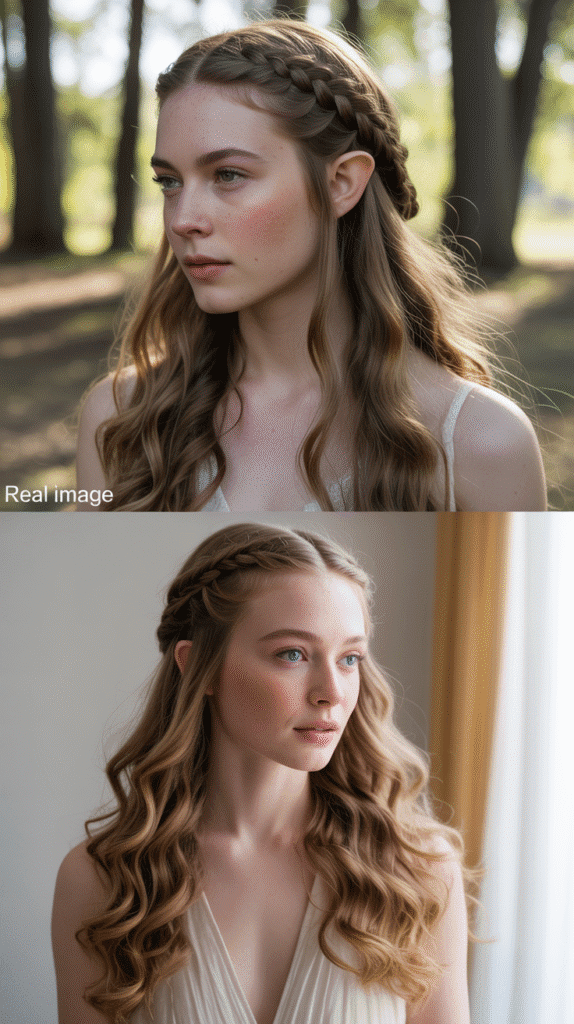Have you ever gazed at fantasy artwork and felt captivated by the ethereal beauty of elven characters, particularly their mesmerizing hairstyles?
The allure of elf hairstyle drawings lies in their ability to transport us to magical realms where elegance meets otherworldly grace.
Whether you’re an aspiring artist seeking fresh ideas, a fantasy enthusiast building your character collection, or simply someone who appreciates the artistry of mythical aesthetics, this comprehensive guide will illuminate your creative journey.
This article on “30 Enchanting Elf Hairstyle Drawings to Spark Your Fantasy Inspiration” explores diverse elven hairstyles ranging from flowing cascades adorned with nature’s elements to intricate braids that tell ancient stories.
We’ll journey through classic fantasy styles, nature-inspired designs, warrior-ready arrangements, and contemporary interpretations that blend traditional elvish beauty with modern artistic flair.
Each style comes with detailed descriptions, artistic techniques, and visual inspiration to help you master the art of drawing these captivating hairstyles.
By the end of this exploration, you’ll possess a treasure trove of ideas that will elevate your fantasy character designs and ignite your imagination in ways you never thought possible.
Contents
- 1 1. Classic Flowing Elven Locks
- 2 2. Intricate Crown Braids
- 3 3. Half-Up Battle-Ready Styles
- 4 4. Nature-Adorned Woodland Styles
- 5 5. High Elven Updos
- 6 6. Asymmetrical Side-Swept Designs
- 7 7. Waterfall Braids with Flowing Sections
- 8 8. Warrior Mohawk Braids
- 9 9. Loose Romantic Waves with Face Framing
- 10 10. Tribal Decorated Braids
- 11 11. Sleek High Ponytails
- 12 12. Double Dutch Braids
- 13 13. Vine and Branch Incorporated Styles
- 14 14. Messy Artful Arrangements
- 15 15. Jeweled Ceremonial Styles
- 16 16. Short Pixie with Pointed Ear Focus
- 17 17. Mermaid-Length Straight Styles
- 18 18. Twisted Rope Braids
- 19 19. Gossamer Fairy-Like Wispy Styles
- 20 20. Color-Gradient Fantasy Styles
- 21 21. Practical Working Styles with Scarves
- 22 22. Wind-Swept Dynamic Motion Styles
- 23 23. Shaved Side Designs with Long Opposite
- 24 24. Elven Dreadlocks with Decorations
- 25 25. Sleek Low Buns with Decorative Pins
- 26 26. Wild Curly Voluminous Styles
- 27 27. Minimalist Straight Bob
- 28 28. Flower Crown Integrated Styles
- 29 29. Futuristic Sleek Styles with Metallic Accents
- 30 30. Classical Greco-Roman Inspired Updos
- 31 Conclusion
1. Classic Flowing Elven Locks
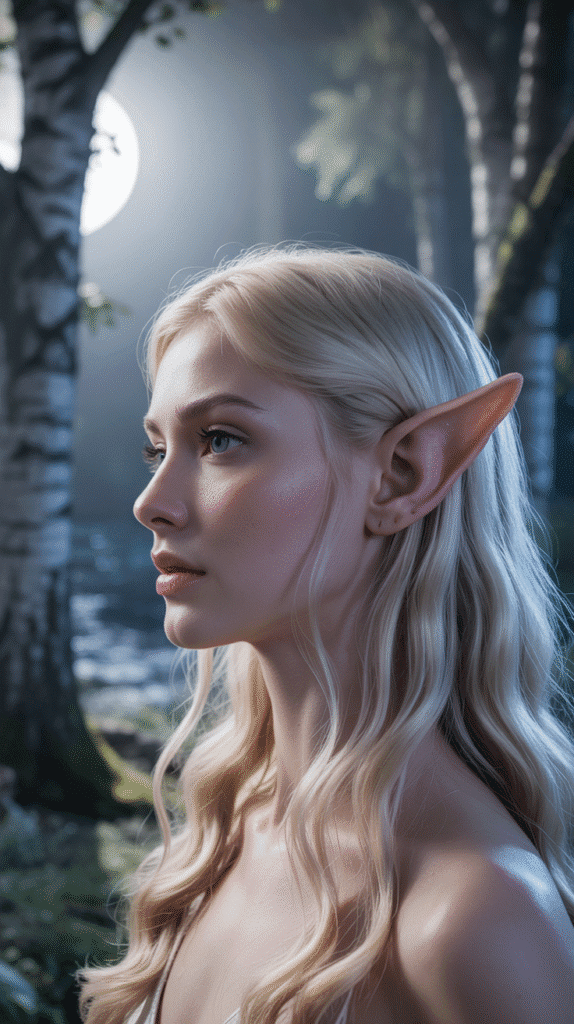
The timeless appeal of classic flowing elven locks represents the quintessential image of elvish beauty that has graced fantasy literature and art for generations.
These hairstyles embody freedom, grace, and the untamed spirit of forest dwellers who move like whispers through ancient woodlands.
Key characteristics of classic flowing styles:
- Long, silky strands that cascade past the shoulders, often reaching the waist or beyond, creating an impression of eternal youth and vitality
- Gentle waves that catch light and shadow, adding dimension and movement to your drawings even in static poses
- Strategic face-framing pieces that soften angular features and draw attention to the pointed ears characteristic of elven anatomy
- Minimal styling or ornamentation, allowing the natural beauty and texture of the hair to take center stage
- Often depicted in platinum blonde, silver, or golden hues that reflect moonlight and starshine
Drawing techniques for flowing hair:
- Use long, confident strokes to establish the overall flow direction and create a sense of movement
- Layer multiple strands at varying lengths to avoid a flat, uniform appearance
- Add subtle highlights along the hair’s outer curves to suggest roundness and volume
- Consider the effect of wind or motion, allowing some strands to drift away from the main mass
- Study real hair physics but exaggerate the smoothness and perfection for that supernatural elven quality
2. Intricate Crown Braids
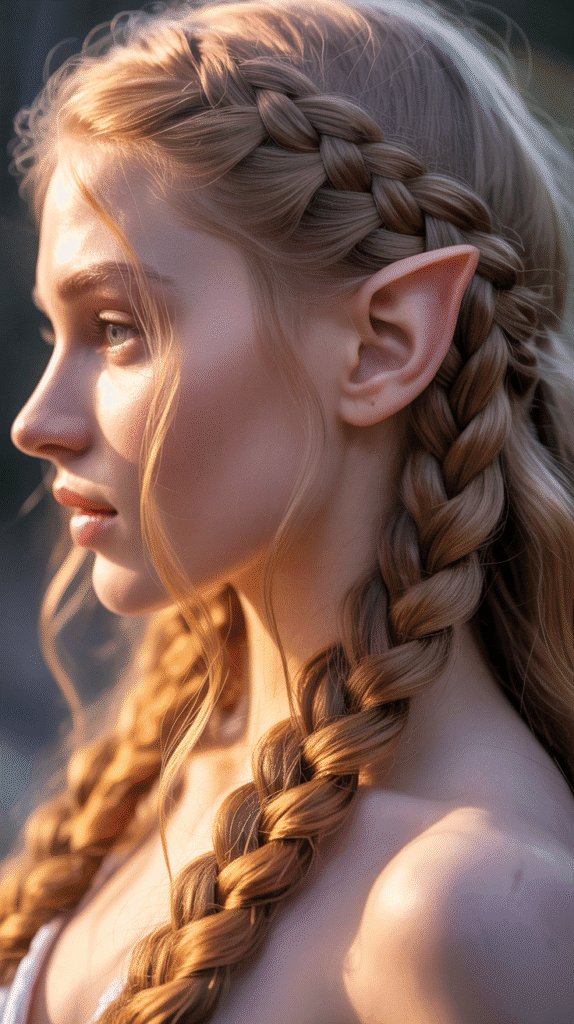
Crown braids represent the regal nature of high elves and noble elven houses, combining practicality with stunning visual complexity.
These styles speak of ancient traditions, ceremonial significance, and the meticulous attention to detail that characterizes elven craftsmanship.
Essential elements of crown braid designs:
- A braid or series of braids that encircle the head like a natural crown, symbolizing nobility and authority
- Often incorporates hair from the front and sides, pulling it away from the face for a clean, elegant silhouette
- Can be executed as a single thick braid or multiple smaller braids woven together in complex patterns
- The remaining hair may flow freely down the back or be incorporated into additional braided elements
- Frequently embellished with delicate accessories like silver threads, small crystals, or tiny flowers
Technical approach for drawing crown braids:
- Begin by mapping out the circular path the braid will follow around the head, establishing proper proportions
- Break down the braid into segments, understanding the over-under-over pattern that creates the woven texture
- Add thickness variation to show which portions of the braid are closer to the viewer
- Include small flyaway hairs to make the style feel lived-in rather than artificially perfect
- Consider the underlying skull structure to ensure the braid sits naturally on the head’s curvature
3. Half-Up Battle-Ready Styles
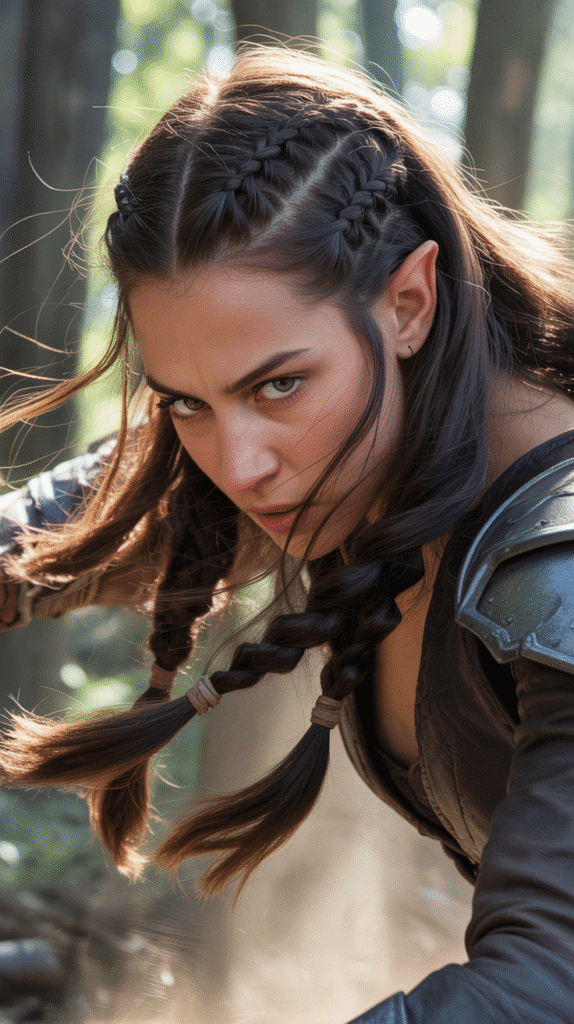
Half-up battle-ready styles strike the perfect balance between functionality and aesthetic appeal, ideal for warrior elves and rangers who need their vision clear during combat while maintaining their cultural identity.
These practical yet beautiful designs showcase the elvish ability to blend utility with artistry.
Defining features of battle-ready half-up styles:
- The top portion of hair pulled back and secured, keeping it away from the eyes and face during movement
- Lower half remains loose, maintaining some traditional elven flowing aesthetic
- Often uses braiding, twisting, or knotting techniques that can withstand rigorous physical activity
- May incorporate leather ties, wooden pins, or metal clasps that serve both decorative and functional purposes
- Designed to stay secure even during combat, horseback riding, or archery
Strategic considerations for drawing these styles:
- Show tension in the pulled-back sections to indicate the hair is firmly secured
- Draw the hairline recession slightly where hair is pulled tight, adding realism
- Include practical fastening mechanisms rather than magical floating arrangements
- Consider showing some shorter pieces that have escaped near the temples or nape
- Add details like leather wrapping or strategic knots that suggest the wearer’s warrior status
4. Nature-Adorned Woodland Styles
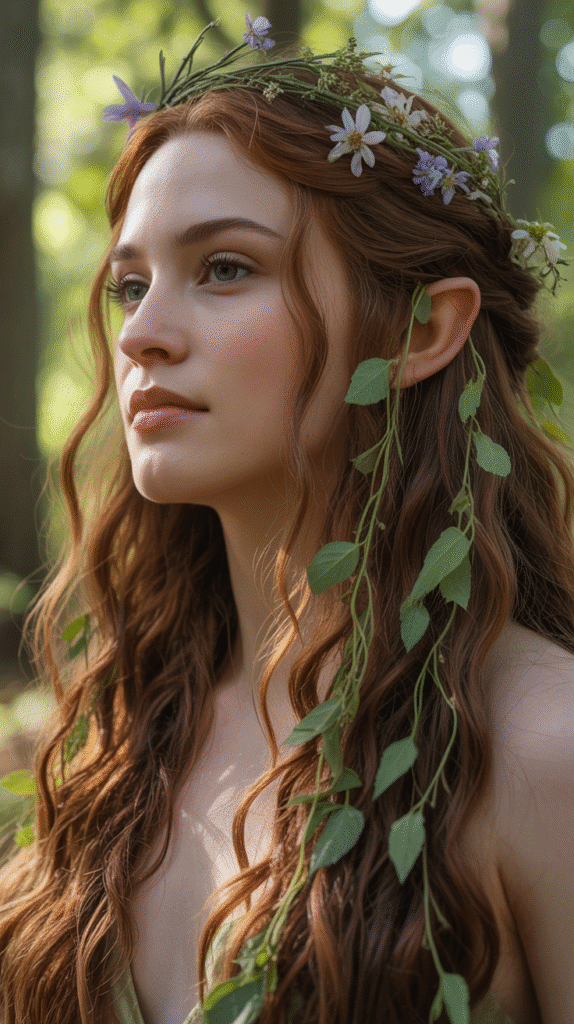
Nature-adorned woodland styles celebrate the deep connection between elves and the natural world, transforming hairstyles into living gardens that blur the line between creature and environment.
These designs are perfect for wood elves, druids, and nature-oriented characters.
Characteristic elements of woodland nature styles:
- Flowers, leaves, vines, or branches woven naturally throughout the hair as if growing directly from it
- Colors that reflect forest environments: moss greens, bark browns, autumn reds, or spring blossom pastels
- Loose, organic arrangements that suggest the hair has been styled by the forest itself
- Strategic placement of natural elements to enhance rather than overwhelm the overall design
- Often combined with flowing or loosely braided base styles that allow nature elements to integrate seamlessly
Artistic techniques for incorporating nature elements:
- Research actual botanical structures to make flowers and leaves look authentic within your fantasy context
- Vary the size and placement of nature elements to create visual interest and avoid monotony
- Use nature elements to guide the viewer’s eye through the composition of your drawing
- Consider seasonal variations when selecting which plants to include in your design
- Add small details like dewdrops on petals or tiny insects to enhance the living garden effect
5. High Elven Updos
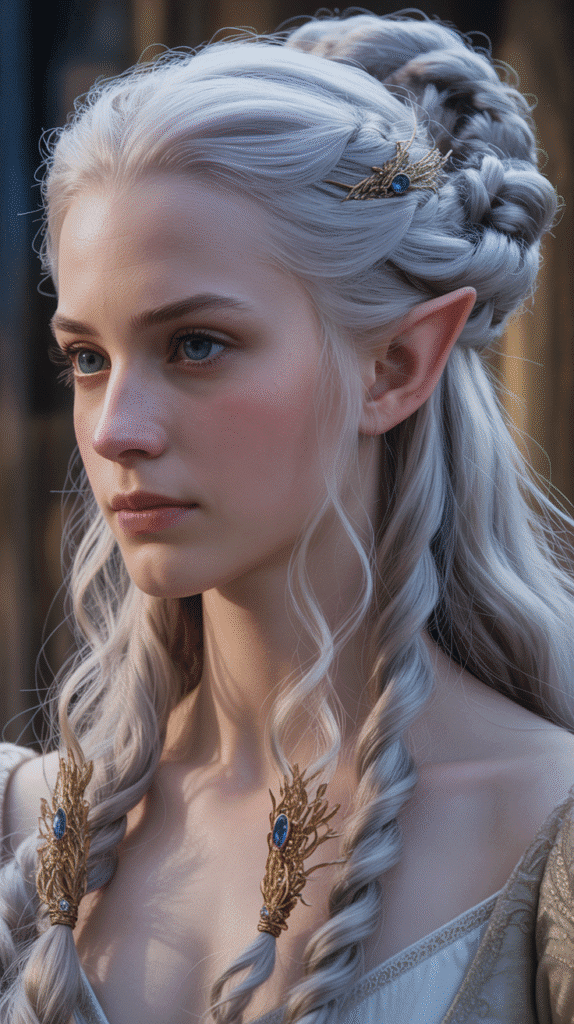
High elven updos represent sophistication, ceremony, and social status within elven hierarchies, showcasing elaborate arrangements that require significant time and skill to create.
These styles are perfect for depicting royal courts, formal ceremonies, and high-ranking elven officials.
Signature aspects of high elven updo designs:
- Hair lifted completely away from the neck and shoulders, creating an elongated, graceful silhouette
- Complex internal structures using pins, twists, and loops that hold the arrangement in place
- Often features cascading elements that fall strategically from the main updo in controlled curls or braided sections
- Incorporates precious metals, gems, or elaborate hair ornaments that reflect wealth and status
- Requires drawing the exposed neck and upper back, which can add elegance to your character design
Technical drawing approach for elaborate updos:
- Begin with a basic understanding of where the bulk of hair weight is positioned
- Use construction lines to establish the updo’s overall shape before adding detailed texture
- Show depth by indicating layers that recede into the arrangement’s interior
- Add decorative elements as focal points but ensure they don’t compete with the face
- Consider the impracticality of such styles as part of their appeal—they’re meant for special occasions
6. Asymmetrical Side-Swept Designs
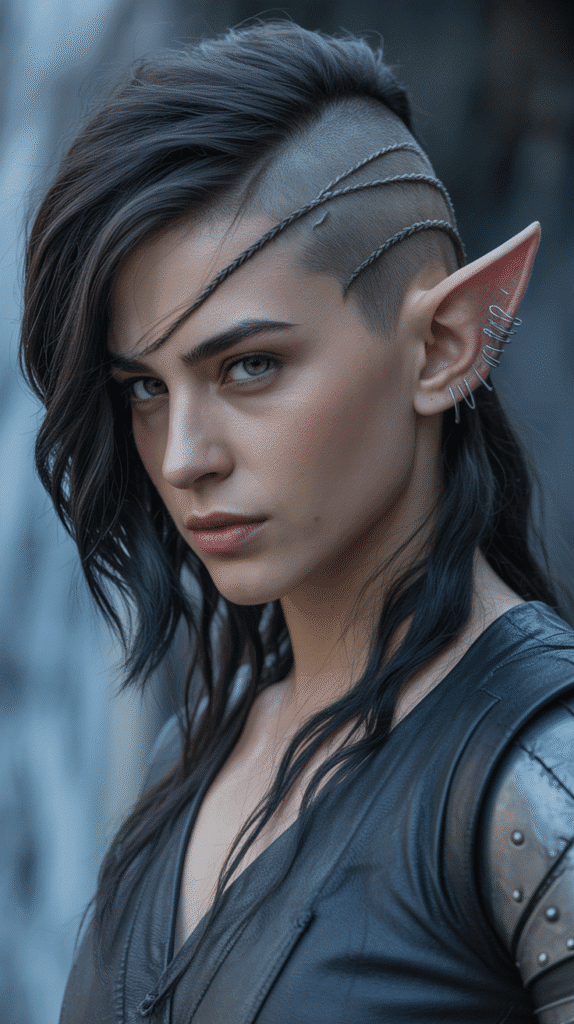
Asymmetrical side-swept designs offer a modern interpretation of elven aesthetics, creating dynamic visual interest through intentional imbalance and movement.
These styles work particularly well for characters with bold personalities or unconventional roles within elven society.
Key features of asymmetrical side-swept styles:
- Dramatically swept to one side, creating visual weight distribution that draws the eye
- One ear fully exposed while the other is partially or fully covered by hair
- Can range from subtly angled to extremely dramatic with one shaved or very short side
- Often includes textural contrasts like smooth sections paired with braided or twisted elements
- Works beautifully for characters who challenge traditional elven conventions
Design considerations for asymmetrical styles:
- Balance the visual composition by considering what’s happening on the “empty” side—perhaps interesting ear jewelry or facial features
- Use the direction of hair flow to lead the viewer’s eye toward the character’s face or other focal points
- Consider how this style would move during action, as the heavy side would swing and shift dynamically
- Experiment with combining smooth and textured sections on different sides for added interest
- This style offers opportunities to show different drawing techniques within a single hairstyle
7. Waterfall Braids with Flowing Sections
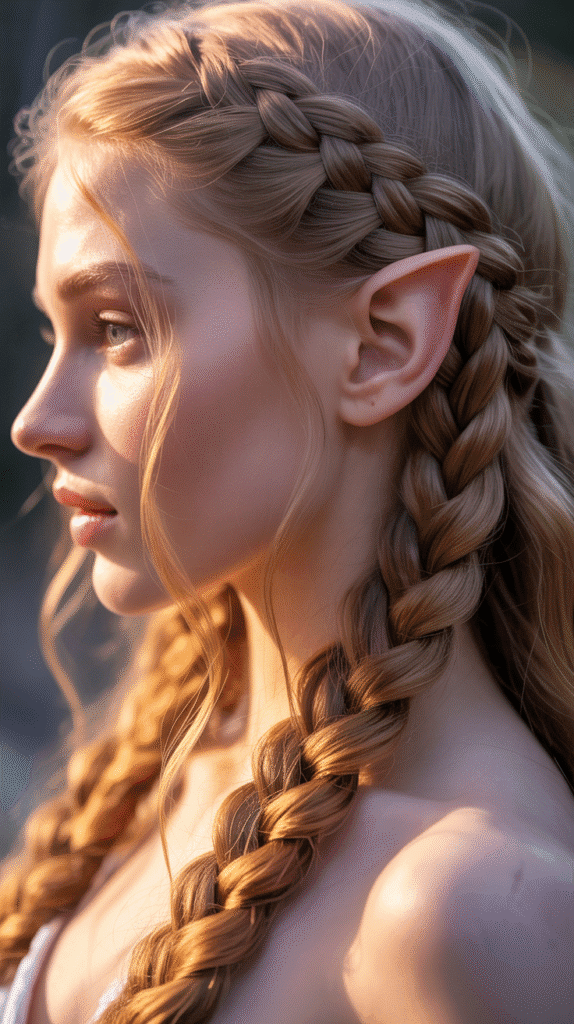
Waterfall braids represent one of the most visually striking braiding techniques available to fantasy artists, creating the illusion of hair flowing through and cascading over the braid like water over rocks.
This style beautifully combines structured braiding with natural flow.
Distinctive characteristics of waterfall braid designs:
- The braid follows a curved path around the head, typically from one side to the other
- Sections of hair are dropped from the braid at regular intervals, allowing them to cascade down like a waterfall
- The dropped sections integrate with the unbraided hair below, creating a seamless transition
- Can be executed as a single waterfall braid or multiple parallel braids for increased complexity
- Often positioned to frame the face or create a crown-like effect around the upper head
Technical execution for drawing waterfall braids:
- Understand the mechanics: unlike regular braids, sections are deliberately dropped and new sections picked up
- Show the dropped strands distinctly falling away from the braid structure at consistent intervals
- Maintain consistent braid thickness while accounting for the loss of hair as sections are dropped
- Add subtle shadows where the braid sits against the head to show dimensionality
- Consider showing the braid from multiple angles to fully capture its three-dimensional structure
8. Warrior Mohawk Braids
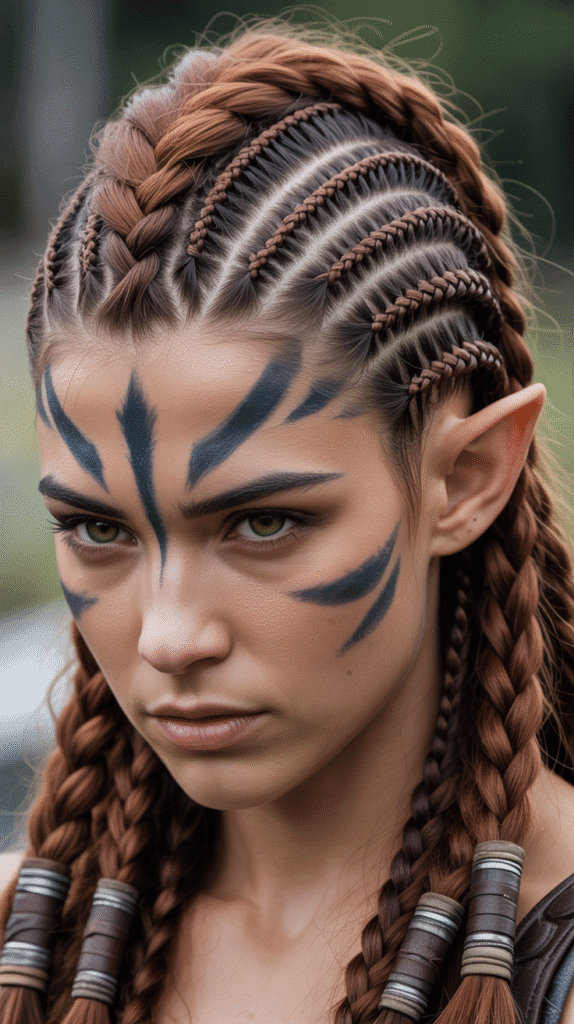
Warrior mohawk braids combine the fierce aesthetic of warrior cultures with traditional elven braiding expertise, creating a bold statement perfect for fighters, guardians, and militaristic elven factions.
This style radiates strength while maintaining technical complexity.
Defining elements of warrior mohawk designs:
- Central strip of hair running from forehead to nape, braided or styled upright while sides are shaved, slicked, or tightly braided against the skull
- Can range from a narrow, precise strip to a wider mohawk that allows for more elaborate styling
- Often incorporates multiple braids within the mohawk section, creating texture and pattern
- May include warrior-specific decorations like leather wrapping, metal beads, or feathers
- The sides might feature subtle designs shaved into short hair for added visual interest
Drawing techniques for mohawk structures:
- Establish the center line of the head to ensure the mohawk is properly aligned
- Show the transition between the raised mohawk section and the sides of the head
- If braided, maintain consistent braid direction (typically front to back) for a natural appearance
- Add volume to the mohawk section to show it standing away from the skull
- Include environmental effects like wind that might affect how the mohawk moves
9. Loose Romantic Waves with Face Framing
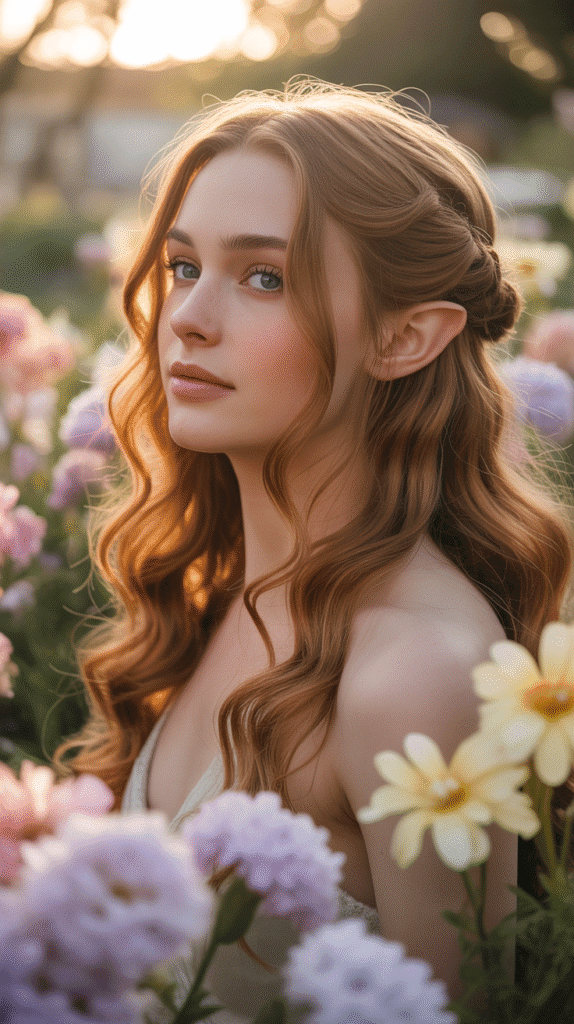
Loose romantic waves with face framing represent the softer, more approachable side of elven beauty, perfect for depicting characters in peaceful moments, romantic scenes, or civilian life.
This style emphasizes natural beauty and gentle femininity or softness.
Essential characteristics of romantic wave styles:
- Soft, gentle waves that suggest natural texture rather than tight curls or pin-straight hair
- Strategic face-framing pieces that draw attention to facial features and soften the overall look
- Often features subtle layering that allows waves to cascade at different lengths
- May include small, delicate braids or twists integrated seamlessly into the waves
- Colors tend toward warm tones—golden blondes, warm browns, or auburn shades with dimensional highlights
Artistic approach for drawing romantic waves:
- Use curved, flowing lines that create S-shaped wave patterns throughout the hair
- Vary wave intensity—tighter near the face, looser through the length—for natural appearance
- Add highlights along the crest of each wave to emphasize the hair’s movement and volume
- Show how face-framing pieces interact with facial contours, perhaps tucking behind ears or sweeping across cheeks
- Keep the overall feel soft by avoiding harsh lines and sharp angles in your line work
10. Tribal Decorated Braids
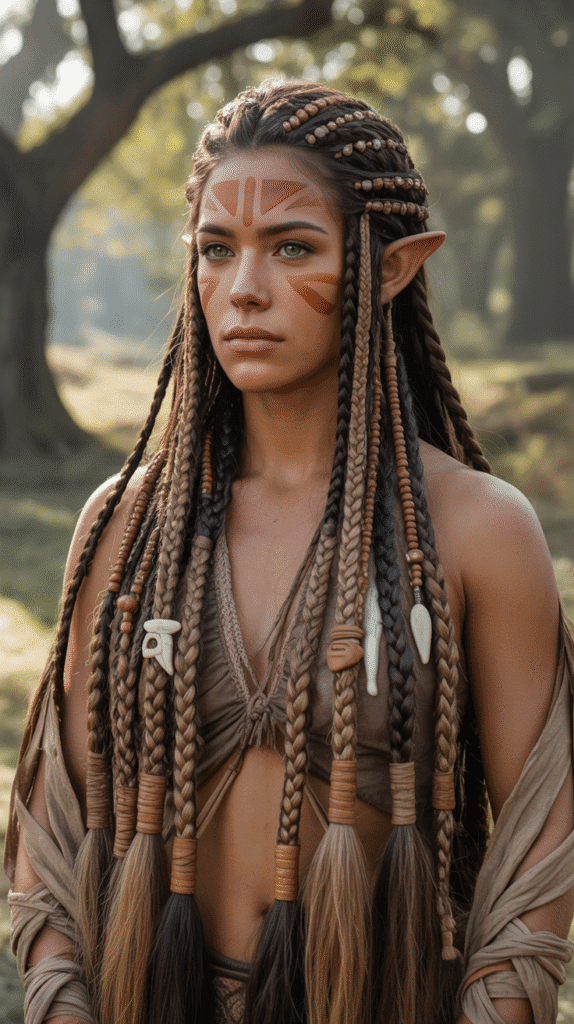
Tribal decorated braids honor the cultural traditions and histories of various elven clans and tribes, incorporating meaningful symbols, colors, and adornments that tell stories of heritage, achievements, and tribal affiliation.
These styles are rich with cultural significance and visual interest.
Key features of tribal decorated braid designs:
- Multiple braids of varying thicknesses arranged in patterns specific to fictional tribal traditions
- Decorations that carry meaning: beads in clan colors, feathers from significant hunts, carved bone or wood charms
- May incorporate threading of colored materials, leather strips, or fabric ribbons throughout the braids
- Often asymmetrical or following specific patterns that identify the wearer’s role within the tribe
- Can include shaved sections with tribal markings or patterns
Cultural and design considerations:
- When creating tribal designs, invent unique cultural systems rather than appropriating real-world indigenous styles
- Assign meaning to decoration choices—bead colors, feather placement, number of braids—to create depth in your worldbuilding
- Consider how different life stages or achievements might be reflected in changing hairstyles
- Show wear patterns on decorations that have been in the hair for extended periods
- Research braiding techniques from various cultures for technical inspiration while creating something distinctly original
11. Sleek High Ponytails
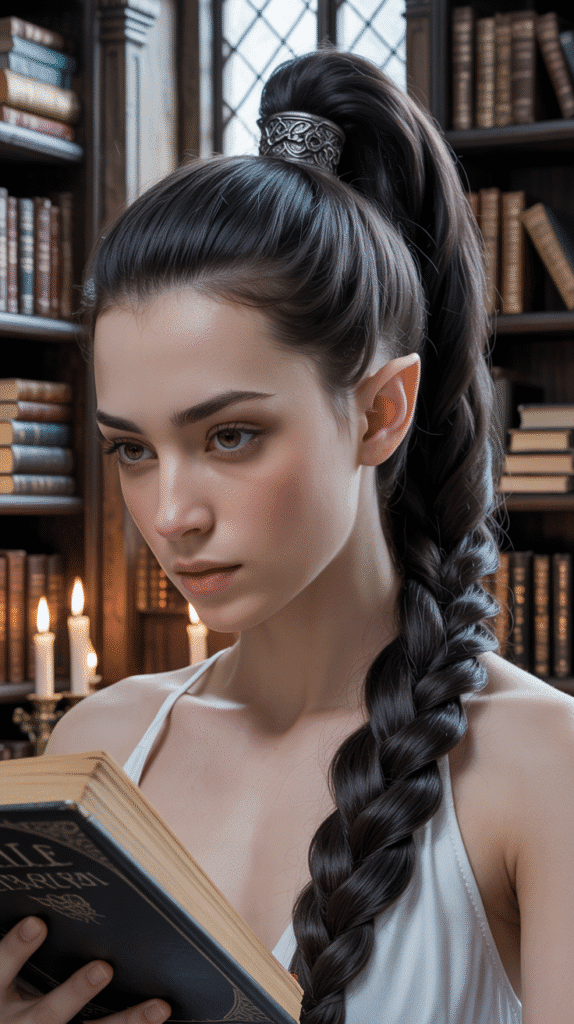
Sleek high ponytails offer a refined, streamlined option that emphasizes facial features and creates a sense of energy and movement.
This style works well for active characters, scholars, or elves who prefer minimalist aesthetics while maintaining elegance.
Characteristic elements of sleek high ponytails:
- Hair gathered at the crown or high on the back of the head, creating lift and exposing the face and neck completely
- Smooth, polished appearance from roots to ponytail base, showing meticulous grooming
- Can be simple and understated or enhanced with decorative ties, wraps, or clasps
- The length of the ponytail itself might be straight, slightly waved, or include braided elements
- This style particularly emphasizes pointed ears and elegant neck lines characteristic of elven anatomy
Technical drawing considerations:
- Show the tension where hair is gathered, indicating it’s pulled tight against the skull
- The ponytail should originate from a specific point, with strands radiating from that central gathering
- Consider gravity’s effect on the ponytail—how it falls and moves based on the character’s position
- Add small details like stray hairs near the temples or nape to avoid an overly artificial appearance
- Use highlights along the smooth sections to emphasize the sleek, polished quality
12. Double Dutch Braids
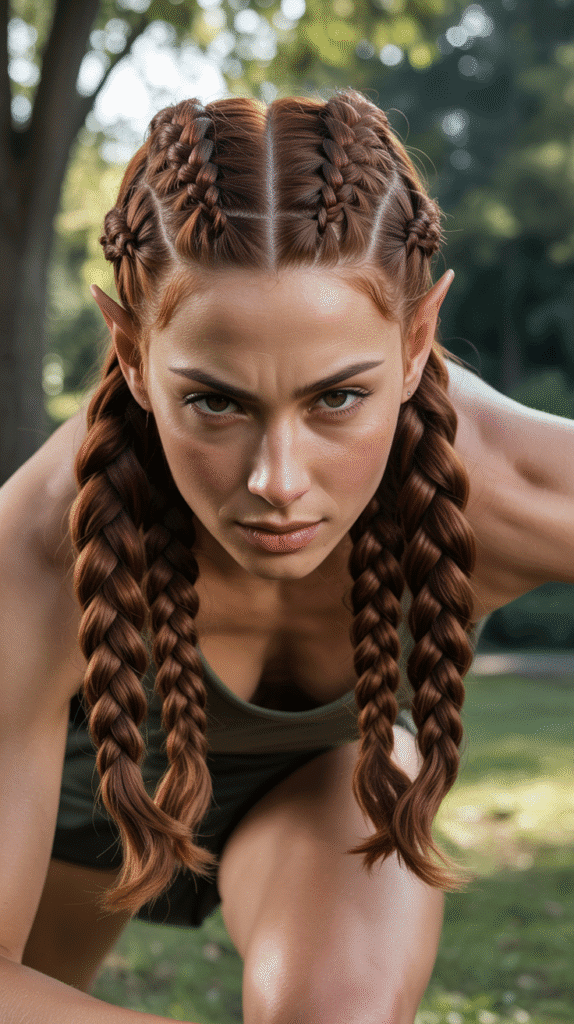
Double Dutch braids provide symmetry, structure, and athletic functionality while offering interesting visual texture through the raised, inverted braiding technique.
This style suits active characters and provides a classic, timeless look that works across various elven subtypes.
Defining features of double Dutch braid styles:
- Two parallel braids running from front to back on either side of a central part
- Dutch braiding technique creates raised, prominent braids that stand out from the scalp
- Symmetrical design creates visual balance and harmony in character portraits
- Can extend the full length of the hair or end at various points with remaining hair flowing freely
- Often practical and sporty while maintaining aesthetic appeal
Technical approach for illustrating Dutch braids:
- Dutch braids are inverted from regular braids—strands cross under rather than over, making them appear raised
- Show the braids sitting on top of the hair surface rather than sinking into it
- Maintain parallel paths for both braids, equidistant from the central part
- Include texture within each braid segment to show the woven structure
- Consider the tightness of the braids—tighter for warriors, looser for casual styles
13. Vine and Branch Incorporated Styles
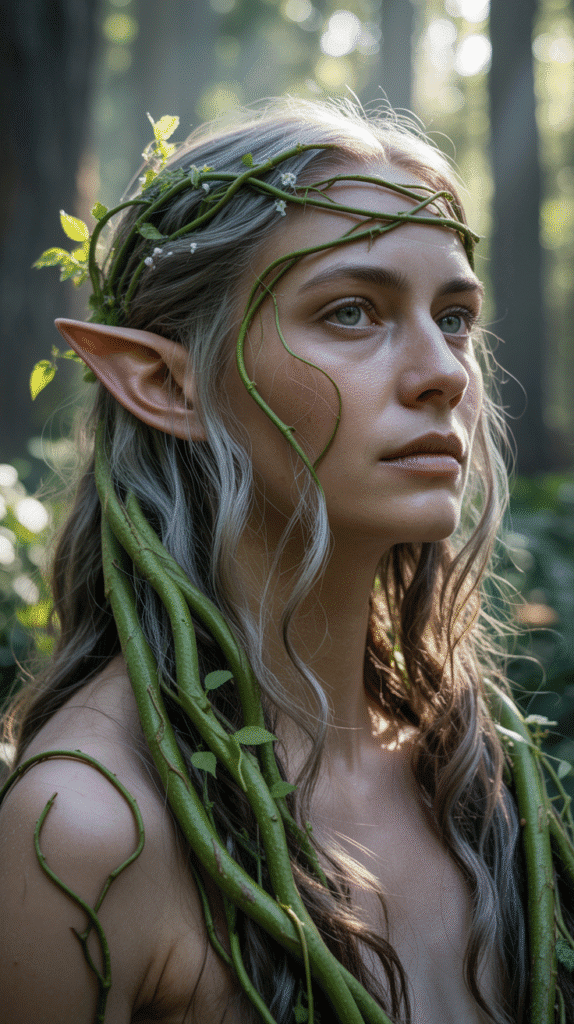
Vine and branch incorporated styles take nature integration to the next level by making plant elements structural components of the hairstyle rather than mere decoration.
These designs suggest a mystical connection between elf and forest, perfect for ancient beings or nature magic users.
Signature aspects of vine-incorporated designs:
- Living vines, branches, or root-like structures woven through the hair as if growing from or with it
- The boundary between hair and plant material is deliberately ambiguous, suggesting organic fusion
- May include small leaves, buds, or even flowers growing directly from the vine elements
- Color gradients that transition from hair color to plant colors, enhancing the organic fusion effect
- Often combined with loose, natural hairstyles that allow vines to weave freely throughout
Artistic techniques for organic integration:
- Study vine growth patterns and how they wrap around structures to make your drawings realistic
- Create visual flow by having vines follow and enhance the hair’s natural movement
- Use color variation to distinguish between hair and plant material while keeping them harmonious
- Add small details like tiny thorns, leaf veins, or bark texture to the plant elements
- Consider showing the vines at different growth stages—new shoots, mature growth, flowering sections
14. Messy Artful Arrangements
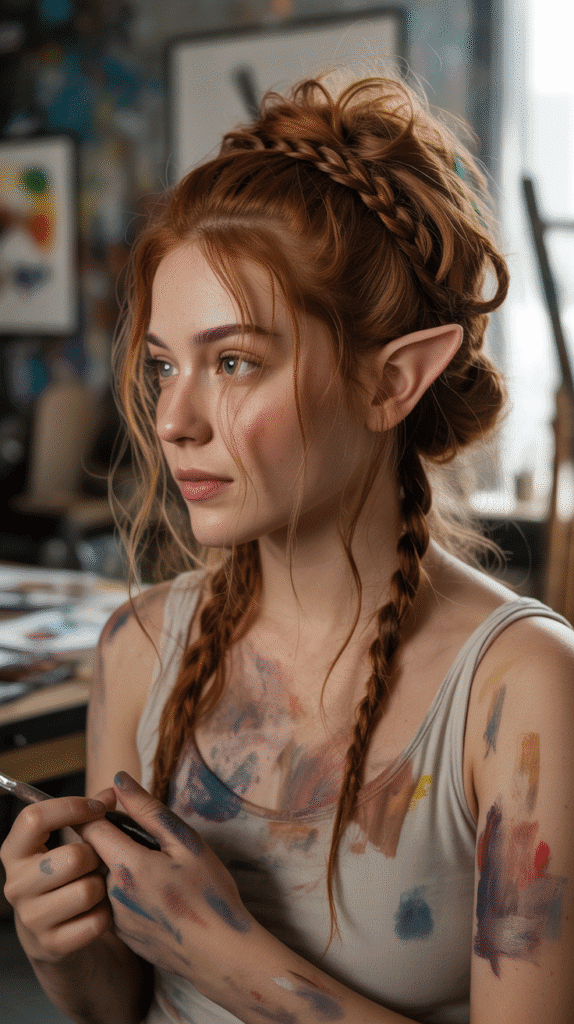
Messy artful arrangements embrace controlled chaos, creating styles that appear effortlessly undone while maintaining artistic intent and visual appeal.
These designs work wonderfully for characters who are carefree, artistic, or caught in casual, unguarded moments.
Key characteristics of artfully messy styles:
- Intentional irregularity with sections pulled loose, twisted at odd angles, or falling asymmetrically
- Combines elements like partial braids, twisted sections, and freely flowing pieces in the same style
- Suggests movement, personality, and a rejection of formal constraints
- Often includes pieces that have “accidentally” escaped from wherever they were secured
- Works particularly well for depicting elves after physical activity, creative work, or intimate moments
Design strategies for controlled messiness:
- Plan the messiness—decide which pieces fall where and why, maintaining artistic composition
- Use varying line weights and textures to enhance the casual, organic feel
- Include details like loosened braid sections or partially undone twists
- Balance the messy elements with some anchoring structure to prevent visual chaos
- Consider what activity might have created this disheveled state for authentic-feeling results
15. Jeweled Ceremonial Styles
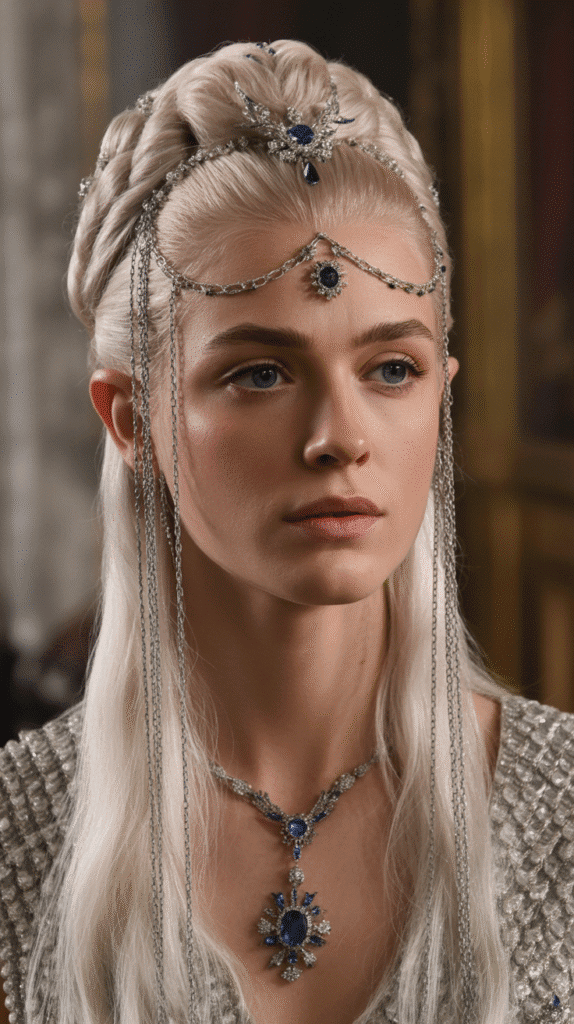
Jeweled ceremonial styles represent the pinnacle of elven formal hairstyling, incorporating precious materials and elaborate designs reserved for the most significant occasions.
These styles showcase wealth, status, and the importance of the event being attended.
Defining elements of jeweled ceremonial designs:
- Extensive use of precious metals, gemstones, crystals, or magical light-emitting elements
- Elaborate structural arrangements that serve as a foundation for displaying valuable adornments
- Often features chains, circlets, or net-like metal structures that drape through and over the hair
- May incorporate family heirlooms, magical artifacts, or culturally significant jewelry pieces
- The hairstyle and jewelry work together as an integrated design rather than separate elements
Artistic considerations for jeweled styles:
- Research historical hair jewelry from various cultures for technical inspiration
- Show how metal chains or structures interact with hair—resting on, weaving through, or suspending from it
- Add appropriate reflections and light refractions from gemstones and polished metals
- Consider the weight of elaborate jewelry and how it might affect hair positioning and draping
- Use jewelry placement to guide the viewer’s eye to focal points within your composition
16. Short Pixie with Pointed Ear Focus
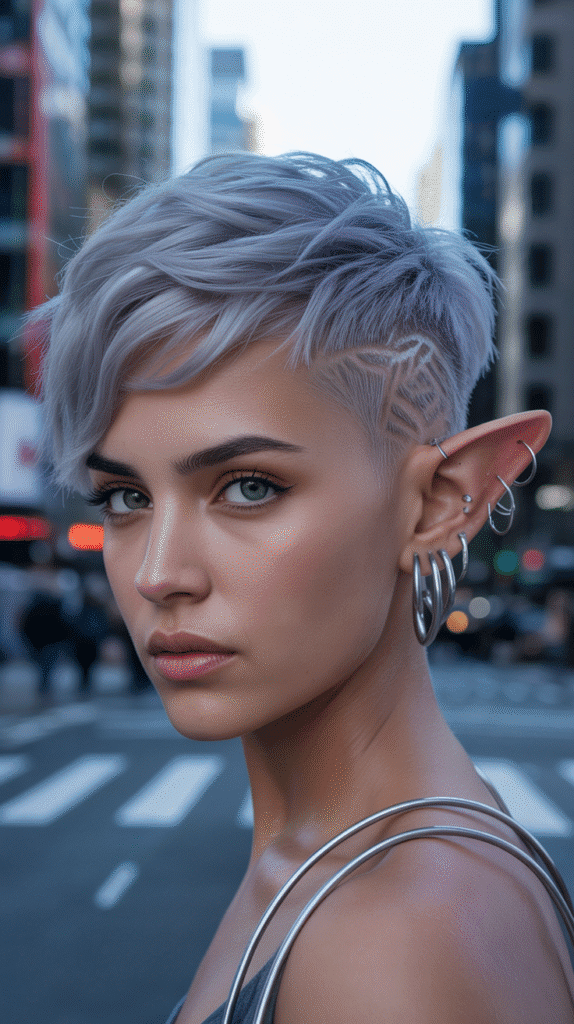
Short pixie styles break from the traditional long-haired elf archetype, offering a modern, bold alternative that places maximum focus on distinctive elven features, particularly the pointed ears.
This style suits contemporary fantasy settings and characters who defy conventions.
Characteristic features of elven pixie cuts:
- Very short hair, typically cut close at the nape and sides with slightly more length on top
- Completely exposes the ears, making them a primary focal point of the character design
- Can be styled sleek and polished or tousled and textured depending on character personality
- Often incorporates subtle asymmetry, like a longer side-swept bang or undercut patterns
- May feature unusual colors or highlights that work well with short hair’s limited canvas
Technical approach for drawing short styles:
- Pay careful attention to how short hair follows the skull’s contour, showing its rounded shape
- Short hair requires focus on texture—individual strands, clipped sections, and growth direction matter more
- The exposed ears become crucial design elements—make them detailed and expressive
- Consider adding ear jewelry or accessories to enhance the focus short hair creates
- Show the hairline and nape clearly, areas often hidden in longer styles
17. Mermaid-Length Straight Styles
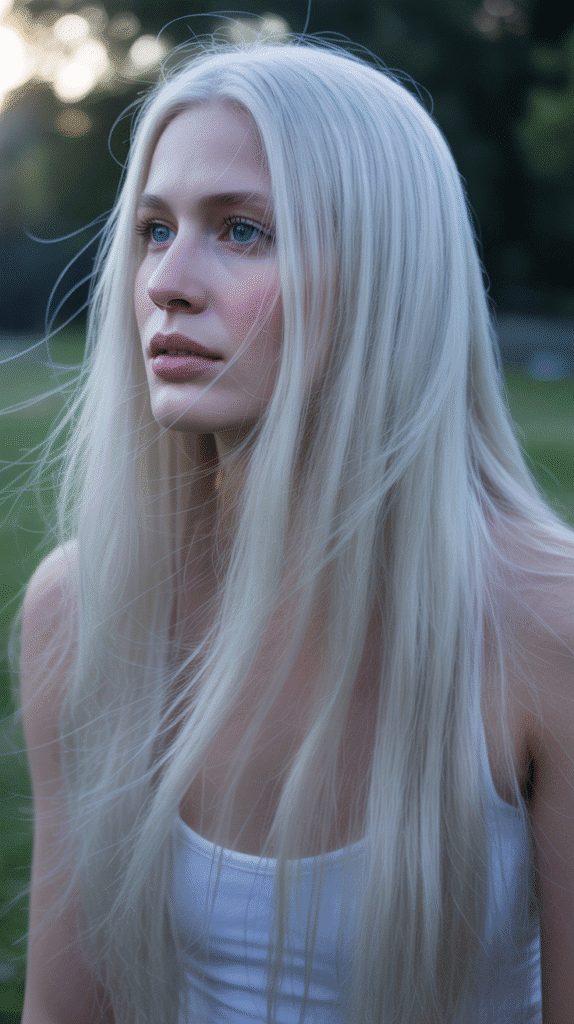
Mermaid-length straight styles showcase hair so long it becomes a defining character feature in itself, emphasizing the supernatural longevity and otherworldly nature of elven beings.
This extreme length requires special consideration in both design and storytelling.
Essential characteristics of mermaid-length hair:
- Hair extending well past the waist, often to the knees or even ankles in extreme cases
- Perfectly straight or with minimal wave, creating dramatic vertical lines in your composition
- Often features subtle color gradients or variations along the length due to the sheer amount of hair
- Requires consideration of how such long hair is managed during daily activities
- Creates dramatic visual impact in action scenes or windy conditions
Design and practical considerations:
- Consider the impracticality of such length—perhaps reserved for non-combatant elves or those with magic to manage it
- Show how the character interacts with their hair—stepping on it, gathering it, or having it caught on things
- Use extreme length to create dynamic compositions, with hair flowing around and behind the character
- Consider environmental effects—such long hair would be dramatically affected by wind, water, or movement
- Add subtle detail variation along the length to show that this much hair has individual character
18. Twisted Rope Braids
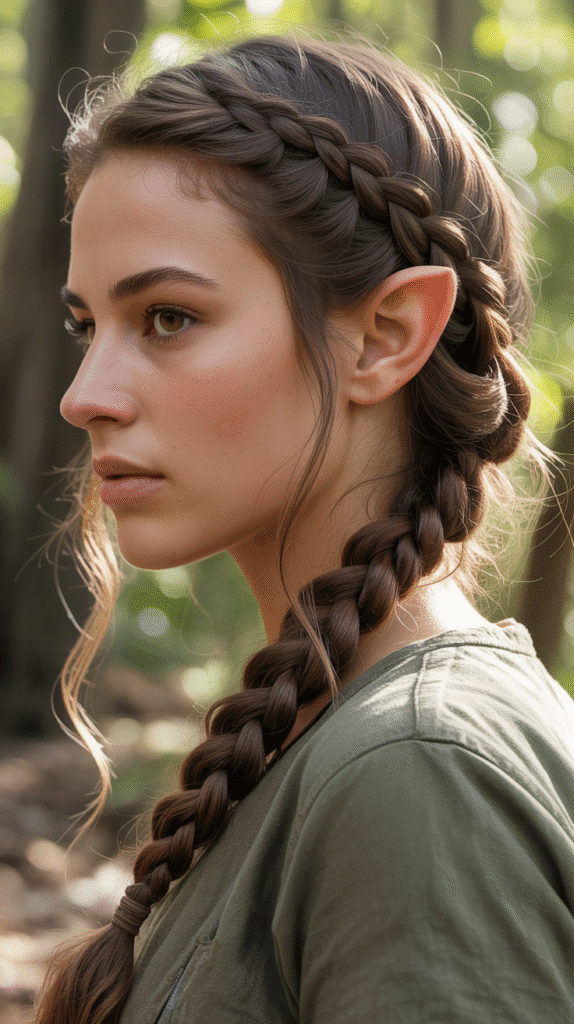
Twisted rope braids offer a simpler alternative to complex braiding while still providing texture, structure, and visual interest.
These styles work well for characters who want polished appearance with less elaborate maintenance than intricate braids require.
Key features of rope braid designs:
- Created by dividing hair into two sections and twisting them around each other
- Simpler construction than three-strand braids but can create dramatic visual impact
- Can be executed as thick, substantial ropes or multiple smaller twisted sections
- Often combined with other styling elements like half-up arrangements or side-swept designs
- Creates an organic, natural texture that suits wood elves and nature-oriented characters
Technical execution for drawing twisted braids:
- Show the two distinct sections spiraling around a central axis
- Each section should twist on itself while also wrapping around its partner
- The twist pattern creates diagonal lines across the braid surface
- Add depth by showing how one section passes in front of the other at regular intervals
- Consider varying the tightness of the twist along the length for visual interest
19. Gossamer Fairy-Like Wispy Styles
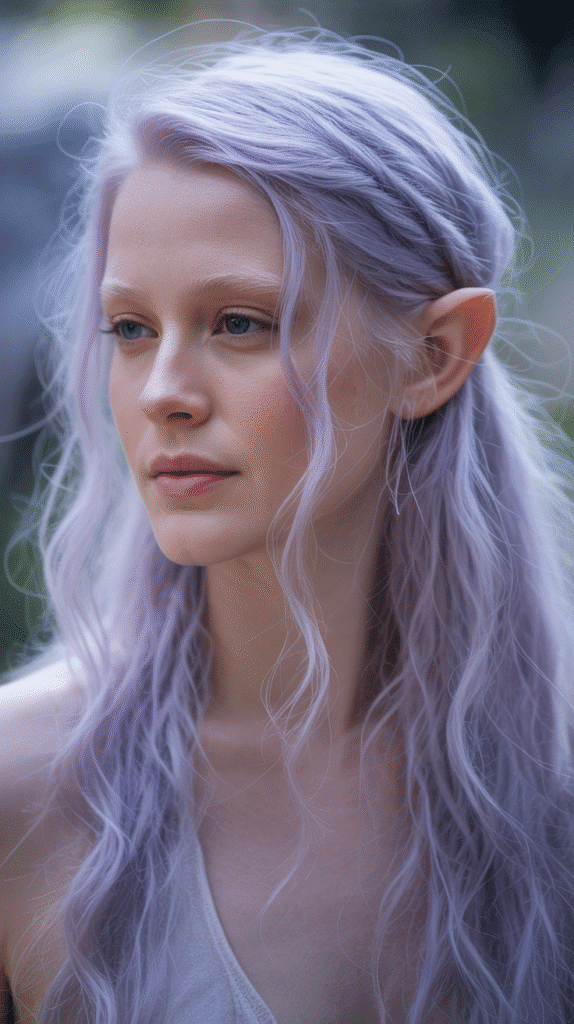
Gossamer fairy-like wispy styles embrace an ultra-delicate, ethereal aesthetic that makes hair appear almost weightless and otherworldly.
These designs work perfectly for high fantasy settings, magical beings, or elves with particularly strong fey connections.
Distinctive characteristics of gossamer wispy styles:
- Very fine, lightweight hair that seems to float and drift on the slightest breeze
- Often depicted in extremely pale or pastel colors that enhance the delicate appearance
- May include sections that appear to defy gravity, floating upward or outward mysteriously
- Incorporates lots of flyaway strands and loose pieces that create a soft, hazy halo effect
- Can include subtle magical elements like sparkles, luminescence, or color-shifting effects
Artistic techniques for gossamer effects:
- Use very light, delicate line work for individual strands
- Add white or light-colored highlights to create a backlit, glowing effect
- Show many individual wispy pieces rather than solid masses of hair
- Consider adding subtle transparency effects where hair is thinnest or most delicate
- Incorporate soft blur effects around the hair edges to enhance the ephemeral quality
20. Color-Gradient Fantasy Styles
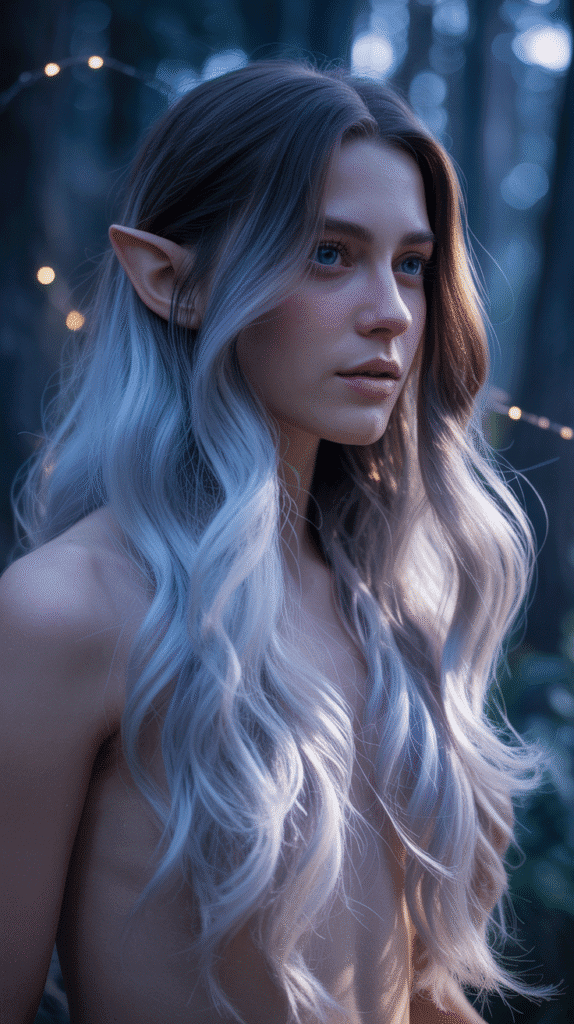
Color-gradient fantasy styles liberate elven hair from realistic color constraints, creating stunning visual effects through graduated color transitions that can represent magical abilities, emotional states, or simply artistic beauty.
These designs make bold statements perfect for high-fantasy settings.
Key aspects of gradient color designs:
- Smooth transitions between two or more colors along the hair length or across sections
- Colors might follow natural gradients (light to dark) or fantasy combinations (blue to purple, pink to silver)
- Can represent magical properties—fire elves with red-to-gold gradients, ice elves with white-to-blue
- The gradient itself becomes a primary design element that influences the overall character aesthetic
- May incorporate multiple gradients in different sections for complex, eye-catching results
Technical considerations for color gradients:
- Plan where transitions occur—roots to tips is most common but lateral gradients can be striking
- Create smooth color blending by using intermediate shades between main colors
- Consider how lighting affects gradient appearance—highlights and shadows alter color perception
- Use gradients to enhance the hair’s form and movement, with colors shifting as the hair curves and flows
- Match gradient colors to character design elements like clothing, eyes, or magical effects
21. Practical Working Styles with Scarves
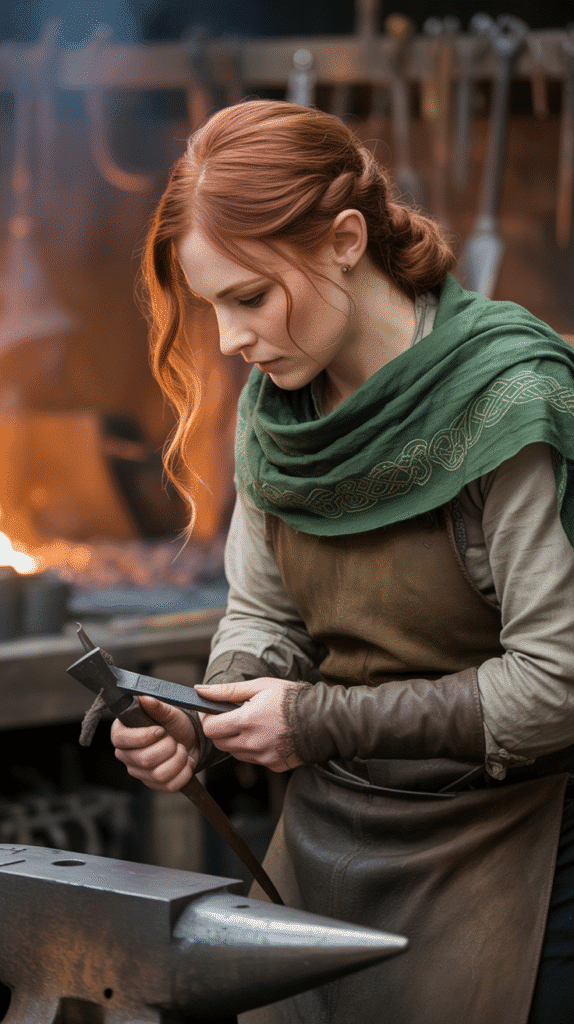
Practical working styles with scarves represent the everyday reality of elven life beyond adventures and ceremonies, showing characters engaged in crafts, farming, or other labor while keeping their hair manageable and protected.
These styles ground your characters in relatable authenticity.
Essential elements of practical scarf-wrapped styles:
- Hair secured away from face and neck for comfort during physical work
- Scarves wrapped around, over, or through the hair for both functional and decorative purposes
- Often combined with braiding or twisting to secure hair before wrapping
- Colors and patterns of scarves can indicate profession, regional origin, or personal taste
- May show some hair escaping the scarf after hours of work, adding realistic wear
Design considerations for working styles:
- Research historical working hairstyles for inspiration on practical hair management
- Show the scarf wrapping technique clearly—knotted at front, back, or side
- Consider what work the character does and how that influences hair styling choices
- Add details like sweat at the hairline or dust/flour in the scarf for authenticity
- Balance practicality with maintaining elvish elegance—even work styles should have grace
22. Wind-Swept Dynamic Motion Styles
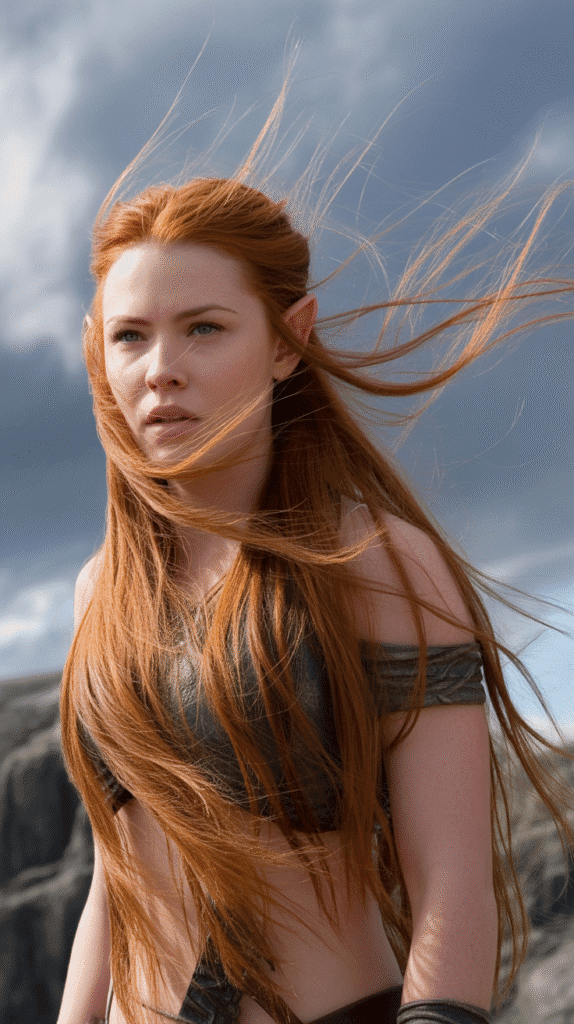
Wind-swept dynamic motion styles capture hair in action, showing the dramatic effects of movement, weather, or magical forces on flowing locks.
These designs add energy and life to your drawings, perfect for action scenes or dramatic moments.
Defining characteristics of wind-swept styles:
- Hair clearly affected by directional force, flowing backward, upward, or to the side
- Individual strands and sections separating and moving independently in the wind
- Creates dynamic, energetic compositions that suggest movement even in still images
- Longer pieces stream out dramatically while shorter sections flutter and lift
- Often reveals the underlying hairstyle structure while adding chaotic beauty
Technical approach for dynamic hair:
- Establish a clear wind direction that affects all hair elements consistently
- Show variation in how different hair sections respond—heavier parts move less than light ones
- Add separation between strands, breaking up solid masses into individual flowing pieces
- Consider the character’s movement direction in relation to wind direction for realistic results
- Use curved, flowing lines that taper to fine points to suggest hair streaming through air
23. Shaved Side Designs with Long Opposite
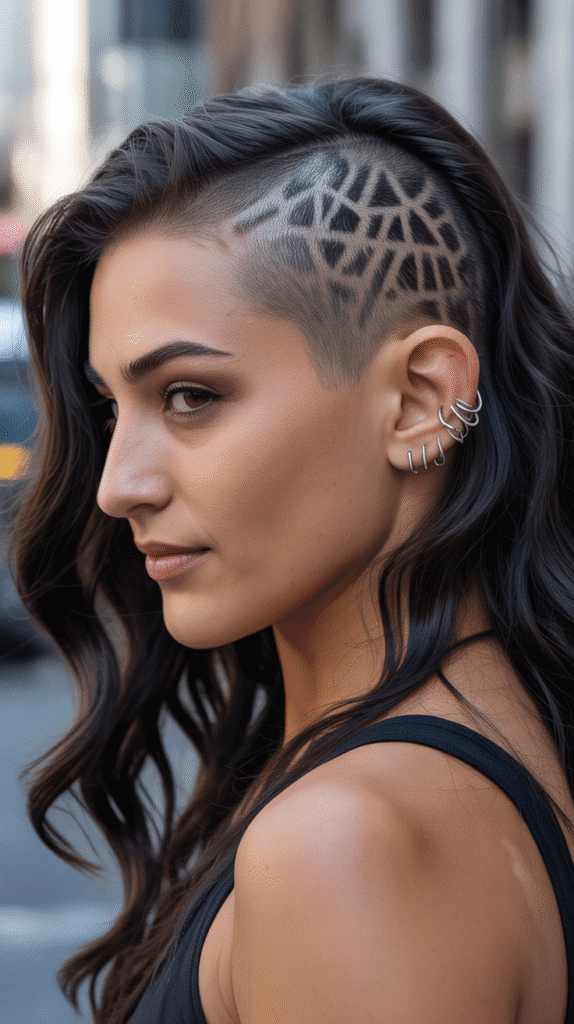
Shaved side designs with contrasting long sections create bold asymmetry that makes a strong visual statement, perfect for rebellious characters, modern fantasy settings, or elves who challenge traditional beauty standards.
This style combines edginess with elegant length.
Key features of shaved-side contrast styles:
- One side (or back) shaved very short or completely bald, creating stark contrast
- Opposite side features long hair that can be styled in various ways
- May include decorative shaving patterns—geometric designs, nature motifs, or tribal patterns
- The long section often gets showcased through specific styling like braids, curls, or swept-over arrangements
- Creates opportunity for creative jewelry placement on the exposed side
Design strategies for dramatic contrast:
- Use the shaved section as negative space that makes the long section more dramatic by contrast
- Consider adding meaningful designs shaved into the short section .
- Show subtle stubble texture on shaved areas to indicate recent maintenance or growth
- Use the exposed scalp area to showcase interesting ear jewelry, tattoos, or natural skin tones
- Balance the composition by considering what visual weight exists on each side of the design
24. Elven Dreadlocks with Decorations
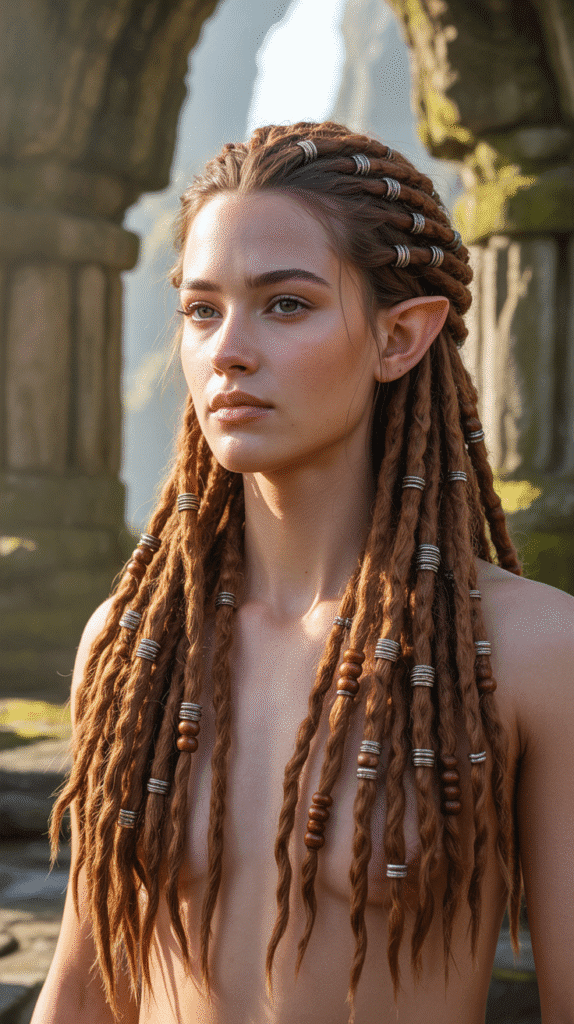
Elven dreadlocks with decorations offer a unique interpretation that combines the textured, sectioned nature of dreadlocks with distinctly elvish aesthetic sensibilities.
This style works beautifully for creating culturally diverse elven communities or characters with specific spiritual practices.
Characteristic elements of elven dreadlock styles:
- Thick, rope-like sections of intentionally matted or locked hair, typically more refined than traditional dreadlocks
- Often thinner and more uniform than human dreadlocks, maintaining that supernatural elven perfection
- Decorated with beads, rings, wraps, or charms that slide along the locks or are woven permanently into them
- May incorporate natural elements like wooden beads, shells, stones, or dried flowers
- Can be styled in various arrangements—worn loose, pulled into ponytails, wrapped into buns, or partially braided together
Technical considerations for drawing dreadlocks:
- Each lock should be roughly cylindrical with subtle texture showing the matted hair structure
- Vary the thickness of individual locks slightly for natural appearance
- Show how locks hang with weight, how they move, and how they interact with each other
- Decorations should appear to actually rest on or wrap around the locks, not float nearby
- Consider the length variation—locks can be uniform or varied lengths for different effects
25. Sleek Low Buns with Decorative Pins
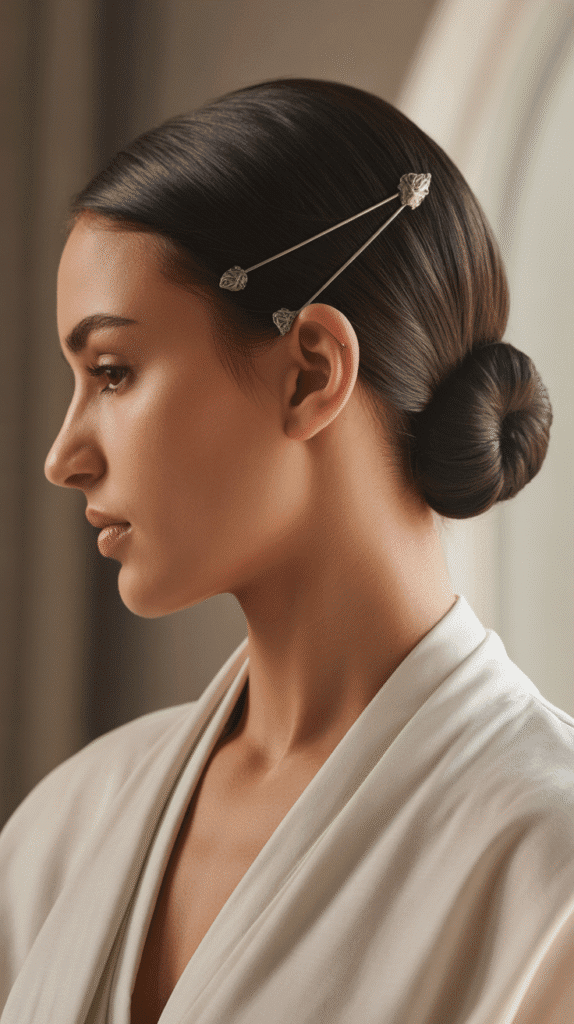
Sleek low buns with decorative pins represent understated elegance and professional sophistication, perfect for scholarly elves, diplomats, healers, or any character whose work requires neat, secure styling.
This timeless style emphasizes grace through simplicity.
Essential features of decorative low bun styles:
- Hair gathered and twisted into a bun positioned at the nape or lower on the head
- Smooth, polished appearance from the crown down to where the bun begins
- Decorative pins, sticks, or combs serve both functional and aesthetic purposes
- Can range from tight, compact buns to softer, loosely gathered arrangements
- Often paired with a clean center or side part for maximum elegance
Design considerations for low buns:
- Show the direction hair flows as it’s gathered toward the bun placement
- Indicate the bun’s internal structure subtly—is it twisted, rolled, or wrapped?
- Decorative pins should appear to actually hold the bun in place, not merely rest atop it
- Consider adding small elegant details like wisps at the nape or temples
- The bun creates opportunity to showcase beautiful neck lines and shoulder curves
26. Wild Curly Voluminous Styles
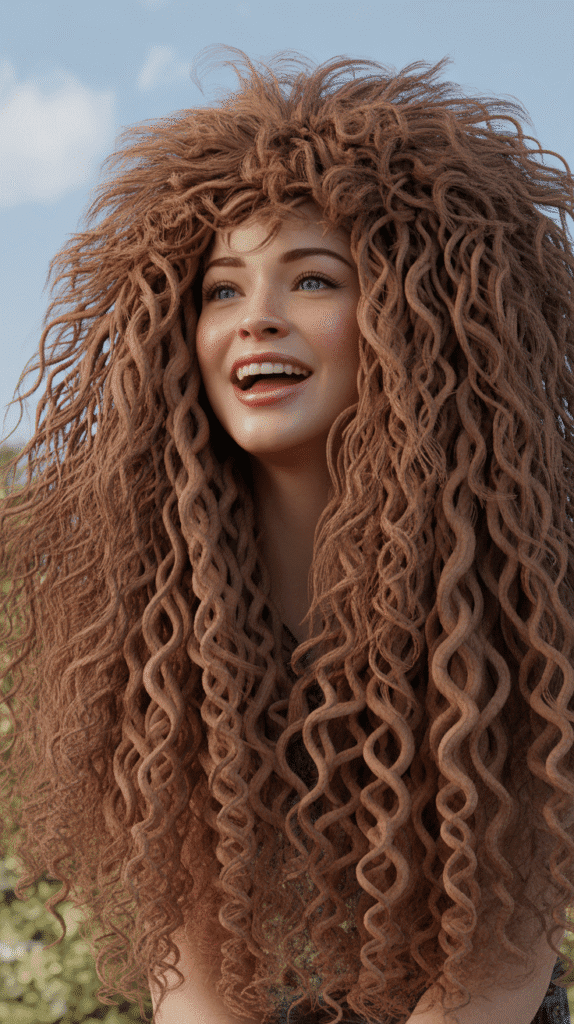
Wild curly voluminous styles celebrate natural texture in its most dramatic form, creating halos of curls that add personality, energy, and visual weight to elven characters.
This style breaks from the smooth, straight hair often associated with elves, offering refreshing diversity.
Defining characteristics of wild curly styles:
- Abundant curls ranging from loose spirals to tight coils, creating significant volume
- Hair expands outward rather than falling straight down, creating a rounded silhouette
- Individual curl definition throughout, showing the spiral pattern and texture
- May include smaller, tighter curls at the roots expanding to larger curls at the ends
- Often appears to have a life of its own, with curls falling in various directions
Technical approach for drawing curly hair:
- Study curl patterns and how spirals form, twist, and stack upon each other
- Show depth by indicating curls in foreground, middle ground, and background layers
- Add highlights where curls curve toward light sources, creating shine on the outer curl surface
- Indicate the overall volume shape before adding individual curl details
- Consider how curls interact with each other, clustering in some areas and separating in others
27. Minimalist Straight Bob
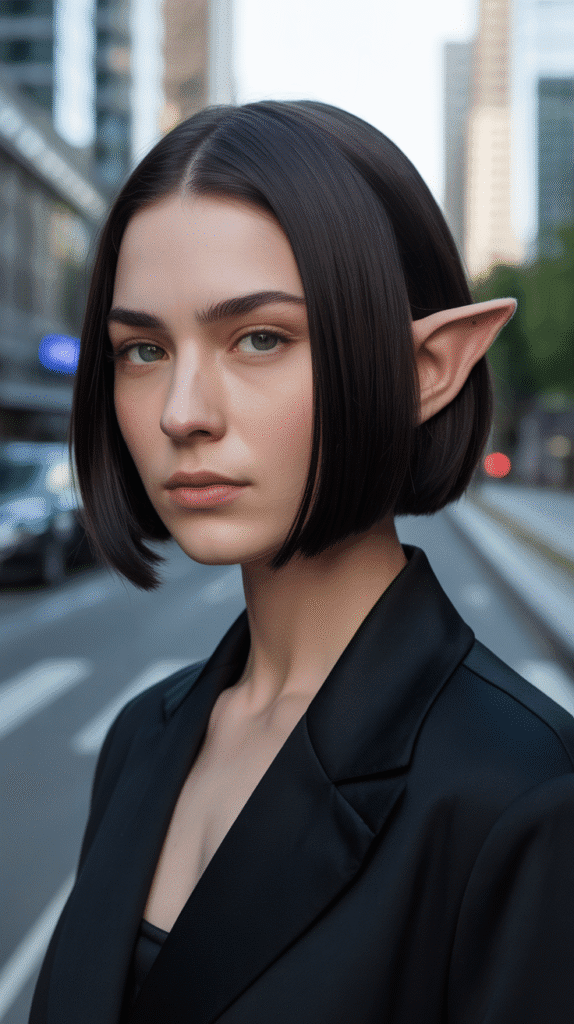
Minimalist straight bob styles offer clean, modern sophistication through precise geometric cuts and impeccable styling.
This contemporary approach suits urban fantasy settings or elves who embrace minimalist aesthetics and modern sensibilities.
Key features of minimalist bob designs:
- Hair cut to uniform length, typically between chin and shoulder level
- Blunt, precise cut line creating strong geometric shape
- Perfectly straight styling emphasizing the clean cut and sharp edges
- Often features a precise part—center, side, or no visible part for maximum sleekness
- The simplicity of the style places emphasis on hair quality, color, and shine
Design considerations for geometric bobs:
- Maintain perfectly straight lines to emphasize the intentional geometric nature
- Show how the bob moves as a cohesive unit rather than individual flowing strands
- Use strong highlights to emphasize the flat, smooth surfaces
- Consider the blunt edge carefully—it should appear sharp and intentional
- The severity of the style makes facial features and expression particularly important
28. Flower Crown Integrated Styles
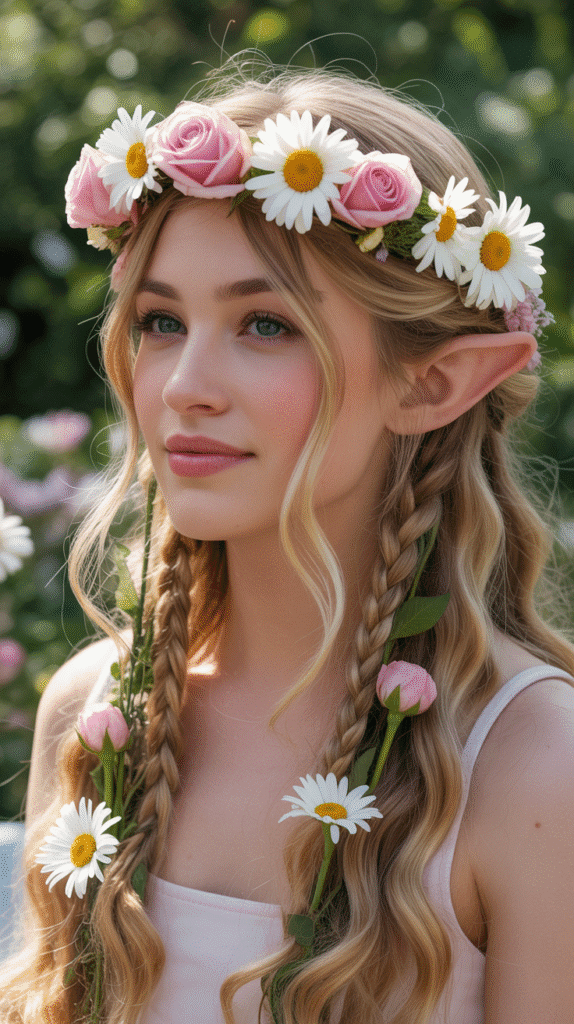
Flower crown integrated styles elevate simple flower crowns from accessories to integral design elements, with blooms appearing to grow from and merge with the hair itself.
These romantic styles work beautifully for ceremonies, festivals, or nature-connected characters.
Characteristic elements of flower crown integration:
- Flowers arranged in crown formation but deeply integrated into the hairstyle structure
- Blending of hair color with flower stems and foliage for seamless integration
- Strategic placement where flowers enhance the hairstyle’s overall shape and flow
- Variety in flower types, sizes, and colors creating visual interest without chaos
- Often combined with braided elements that incorporate flower stems naturally
Artistic techniques for flower integration:
- Position flowers so they appear structurally supported by hair, not magically floating
- Use foliage and smaller flowers to create transitions between hair and blooms
- Consider seasonal appropriateness when selecting flowers for your design
- Show flowers at various angles and stages—some fully open, others partially closed
- Add small details like stamens, petals with natural imperfections, and realistic leaf structures
29. Futuristic Sleek Styles with Metallic Accents
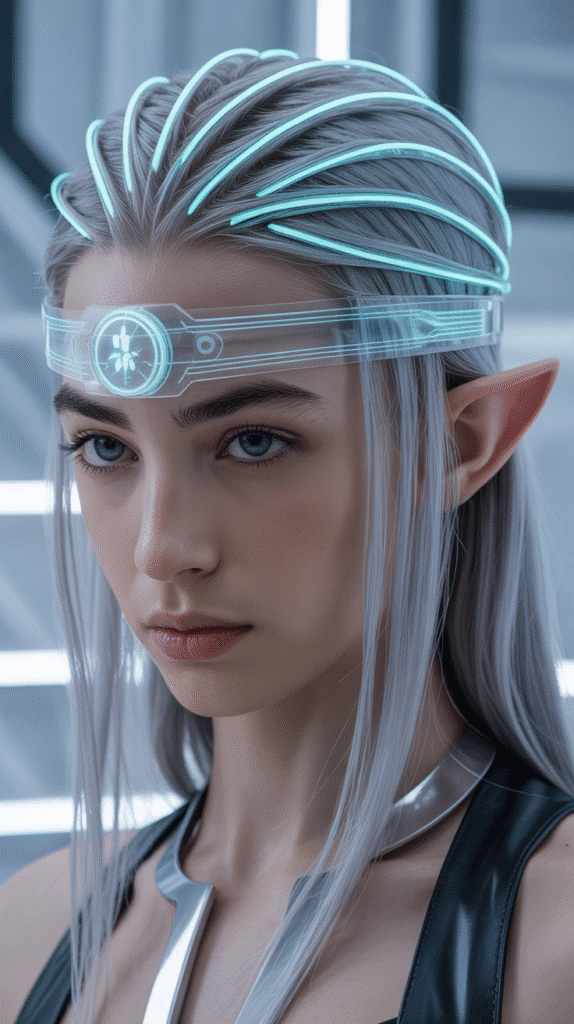
Futuristic sleek styles with metallic accents push elven aesthetics into science fantasy territory, combining traditional elvish grace with technological or magical enhancements.
These designs work perfectly for space opera settings, advanced magical civilizations, or genre-blending narratives.
Defining features of futuristic metallic styles:
- Ultra-sleek, polished hair suggesting advanced grooming techniques or magical maintenance
- Metallic threads, fiber optics, or technological elements woven through or attached to hair
- Geometric precision in styling, creating angular or architectural shapes
- May include glowing elements, color-changing sections, or holographic effects
- Often incorporates materials beyond traditional hair accessories—circuitry, crystalline structures, or energy fields
Design strategies for futuristic integration:
- Balance organic hair texture with artificial technological elements for harmonious integration
- Use metallic accents to create visual paths that guide the viewer’s eye through the design
- Consider what technology level your setting supports when adding sci-fi elements
- Show how traditional elven aesthetic principles adapt to futuristic contexts
- Add subtle glow effects or reflective surfaces on technological components
30. Classical Greco-Roman Inspired Updos
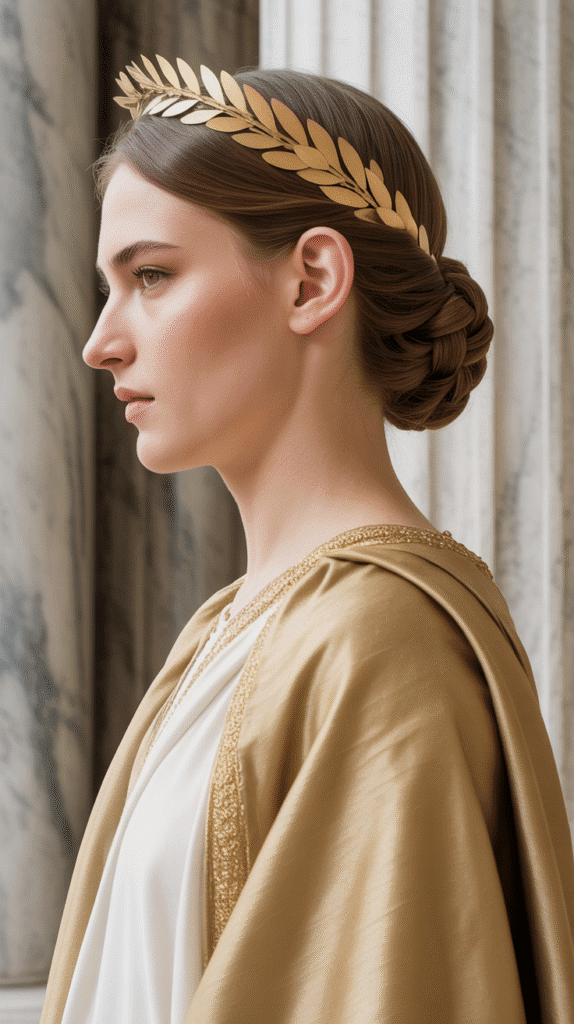
Classical Greco-Roman inspired updos draw from ancient Earth aesthetics to create timeless elegance that suits high elven cultures, classical fantasy settings, or characters with scholarly or aristocratic backgrounds.
These styles combine historical inspiration with elvish refinement.
Essential characteristics of classical-inspired designs:
- Hair pulled back and arranged in elegant loops, twists, or coils reminiscent of Greek and Roman sculptures
- Often features central part with hair smoothly drawn back from the face
- May incorporate gold accessories, laurel wreaths, or ribbon bindings in classical style
- Creates statuesque, dignified appearance emphasizing bone structure and profile
- Combines multiple technical elements—twisting, pinning, and draping—in one cohesive style
Technical considerations for classical styles:
- Study actual ancient hairstyles from historical references and sculptures for authentic inspiration
- Show the smooth surface of pulled-back sections leading to more textured updo areas
- Indicate the structural support system—where pins would logically hold arrangements in place
- Consider symmetry, which was highly valued in classical aesthetics
- Add classical accessories that feel appropriate to elven culture while echoing historical references
Conclusion
The journey through these 30 Enchanting Elf Hairstyle Drawings to Spark Your Fantasy Inspiration reveals the extraordinary diversity and creative potential within elven character design.
From the timeless elegance of flowing locks and intricate crown braids to bold contemporary interpretations like asymmetrical cuts and futuristic metallic accents, each style offers unique opportunities to express character personality, cultural background, and narrative context.
Whether you’re drawn to the practical beauty of warrior braids, the romantic softness of flower-crowned waves, or the wild energy of voluminous curls, these hairstyle options provide a comprehensive toolkit for bringing your elven characters to life.
The integration of natural elements, decorative embellishments, and varied textures demonstrates how hair can function as both aesthetic element and storytelling device.
As you incorporate these styles into your artwork, remember that the most compelling designs emerge when technical skill meets imaginative interpretation, allowing you to create elven characters that feel authentic, memorable, and uniquely yours.
May these enchanting hairstyle inspirations fuel your creative fire and help you craft elven characters that captivate viewers and inhabit your fantasy worlds with grace, power, and undeniable presence for years to come.



